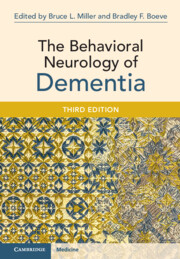Book contents
- The Behavioral Neurology of Dementia
- The Behavioral Neurology of Dementia
- Copyright page
- Contents
- Contributors
- Acknowledgments
- Cover Art
- Abbreviations
- Section 1 Introductory Chapters on Dementia
- Chapter 1 Dementia at the Bedside
- Chapter 2 Brief Cognitive Assessment
- Chapter 3 Neuropsychiatric Symptoms of Dementias
- Chapter 4 Neuropathology of Dementia
- Chapter 5 Neurotransmitters and Neuromodulators in Dementia
- Chapter 6 Cerebrospinal Fluid, Molecular Neuroimaging, and Blood Biomarkers of Neurodegenerative Disease: Past, Present, and Future
- Chapter 7 Magnetic Resonance Imaging in Dementia
- Chapter 8 Epidemiology and Risk Factors for Dementia
- Chapter 9 Genetic Approaches to Neurodegenerative Disease
- Section 2 The Dementias
- Section 3 Treatment of the Dementias
- Index
- References
Chapter 5 - Neurotransmitters and Neuromodulators in Dementia
from Section 1 - Introductory Chapters on Dementia
Published online by Cambridge University Press: 17 November 2025
- The Behavioral Neurology of Dementia
- The Behavioral Neurology of Dementia
- Copyright page
- Contents
- Contributors
- Acknowledgments
- Cover Art
- Abbreviations
- Section 1 Introductory Chapters on Dementia
- Chapter 1 Dementia at the Bedside
- Chapter 2 Brief Cognitive Assessment
- Chapter 3 Neuropsychiatric Symptoms of Dementias
- Chapter 4 Neuropathology of Dementia
- Chapter 5 Neurotransmitters and Neuromodulators in Dementia
- Chapter 6 Cerebrospinal Fluid, Molecular Neuroimaging, and Blood Biomarkers of Neurodegenerative Disease: Past, Present, and Future
- Chapter 7 Magnetic Resonance Imaging in Dementia
- Chapter 8 Epidemiology and Risk Factors for Dementia
- Chapter 9 Genetic Approaches to Neurodegenerative Disease
- Section 2 The Dementias
- Section 3 Treatment of the Dementias
- Index
- References
Summary
The brain neuromodulatory systems consist of small regions in the brainstem, pontine nucleus, and basal forebrain that regulate cognitive behavior by releasing neurotransmitters. Ascending projections from the brainstem and basal forebrain regions spread these neurotransmitters to broad areas of the central nervous system within the frontal cortex, anterior cingulate, or hippocampus, signaling a range of neural pathways. The modulator effect executed in these brain areas, together with the interplay between the systems, is crucial for regulating and adjusting many cognitive and behavioral functions. Neurodegenerative disease processes frequently affect the normal functioning of these modulator circuitries, directly leading to or contributing to the appearance of cognitive and neuropsychiatric symptoms. Even though these neuromodulatory systems’ impairment and imbalance happen early, further efforts to understand better their neurobiological basis are warranted . Hence, this chapter aims to review the role of the neuromodulatory systems in behavior and cognition and how their dysfunction shapes the neurodegenerative dementia phenotype.
Keywords
Information
- Type
- Chapter
- Information
- The Behavioral Neurology of Dementia , pp. 75 - 86Publisher: Cambridge University PressPrint publication year: 2025
References
Accessibility standard: WCAG 2.1 AA
Why this information is here
This section outlines the accessibility features of this content - including support for screen readers, full keyboard navigation and high-contrast display options. This may not be relevant for you.Accessibility Information
Content Navigation
Allows you to navigate directly to chapters, sections, or non‐text items through a linked table of contents, reducing the need for extensive scrolling.
Provides an interactive index, letting you go straight to where a term or subject appears in the text without manual searching.
Reading Order & Textual Equivalents
You will encounter all content (including footnotes, captions, etc.) in a clear, sequential flow, making it easier to follow with assistive tools like screen readers.
You get concise descriptions (for images, charts, or media clips), ensuring you do not miss crucial information when visual or audio elements are not accessible.
Visual Accessibility
You will still understand key ideas or prompts without relying solely on colour, which is especially helpful if you have colour vision deficiencies.
Structural and Technical Features
You gain clarity from ARIA (Accessible Rich Internet Applications) roles and attributes, as they help assistive technologies interpret how each part of the content functions.
